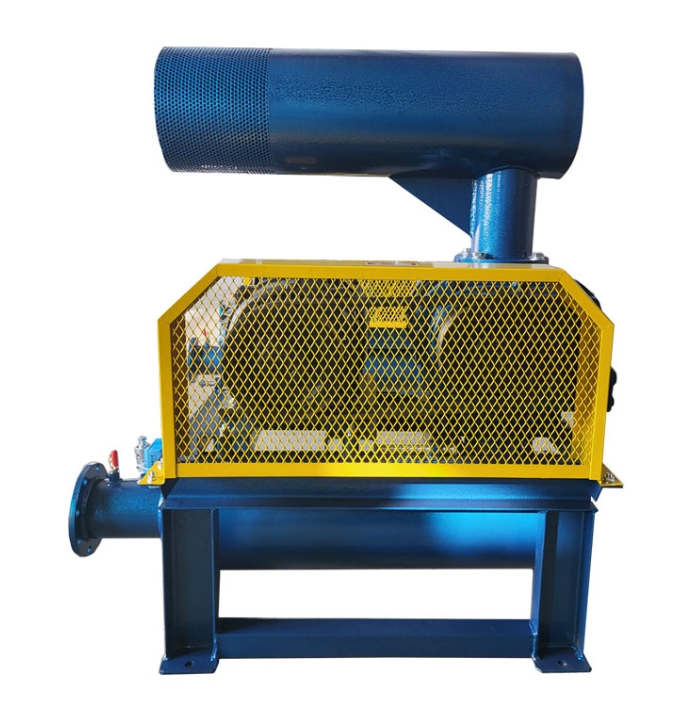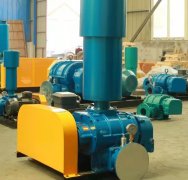Roots blower is a type of positive displacement fan, whose core principle is to rotate a pair of interlocked rotors inside the casing, sucking gas in from the inlet and forcing it towards the outlet. Its structure mainly includes the following key parts:
---

**1. Main structural components**
**(1) Rotor (impeller/helical gear)**
-* * Shape * *: Usually a two leaf or three leaf type (three leaf is more common and has lower noise).
-* * Material * *: Cast iron, stainless steel, or special alloys (corrosion-resistant or high-temperature resistant).
-* * Features * *:
-Two rotors * * are identical * * and are maintained in mesh through * * synchronous gears * *.
-There is no contact between the rotors, leaving a small gap (0.1~0.4mm) to avoid wear.
**(2) Shell (cylinder)**
-Function: To accommodate the rotor and form a closed working chamber.
-Material: Cast iron or welded steel plate, with precision machining on the inner wall to ensure airtightness.
-* * Structure * *:
-Air intake and exhaust ports: usually located on both sides of the casing, with customizable directions (horizontal or vertical).
-Cooling design: Some models come with heat dissipation fins or water-cooled jackets (for high temperature conditions).
**(3) Synchronous gear**
-* * Function * *: Ensure that both rotors * * rotate synchronously in reverse * *, maintaining a fixed gap.
-Material: Alloy steel, quenched to improve wear resistance.
-Installation position: located at the rotor shaft end, integrated with the bearing housing.
**(4) Bearings and Seals**
-* * Bearing * *:
-Adopt * * rolling bearings * * (such as deep groove ball bearings) or * * sliding bearings * * (high-power models).
-Support the rotor shaft and withstand axial/radial loads.
-Sealing:
-Shaft seal: To prevent gas leakage, commonly used labyrinth seals, mechanical seals, or packing seals are commonly used.
-* * Special seal * *: Double end mechanical seals are required when transporting flammable and toxic gases.
**(5) Drive system**
-* * Motor * *: Drive the active rotor directly through a coupling or pulley.
-* * Transmission mode * *:
-* * Direct connection * *: Compact, suitable for medium and large fans.
-Belt drive: Adjustable speed, suitable for low-power models.
---
**2. Auxiliary system (optional configuration)**
-* * Muffler * *: Installed at the inlet/outlet to reduce airflow noise.
-* * Filter * *: The air inlet filters dust and protects the rotor.
-Valve: prevents overpressure damage to the fan (usually set to 1.1 times the rated pressure).
-Lubrication system: Gears and bearings need to be regularly lubricated with oil or grease.
-Variable frequency control system: Adjust the motor speed to achieve flow control.
---
**3. Core working principle**
1. * * Inhalation stage * *: When the rotor rotates, the volume on the inlet side increases, creating negative pressure to suck in gas.
2. Closed transport: Gas is enclosed in the cavity between the rotor and the casing, and moves towards the exhaust port as the rotor rotates.
3. * * Exhaust Stage * *: The engagement of the rotor reduces the volume of the chamber, forcing the gas to be expelled.
>* * Key feature * *: The gas delivery process * * has no internal compression * *, and the pressure is determined by the resistance of the exhaust side system.
---
**4. Typical structural schematic diagram**
```
Air intake
↓
┌───────────────┐
│ Rotor A → ← Rotor B │← Synchronous gear
└───────────────┘
↑
exhaust port
```
---
**5. Design Features and Advantages**
-* * Simple and sturdy * *: No valves, pistons or other vulnerable parts, low failure rate.
-Oil free design: No lubrication between rotors, delivering pure gas (suitable for the food and pharmaceutical industries).
-Bidirectionality: The reverse rotor can switch the intake/exhaust direction (gear phase needs to be adjusted).
---
**6. Common variants and improvements**
-Three leaf type: lower noise and smaller pulsation than two leaf type, becoming mainstream.
-* * Dense * *: Compact design, integrated muffler and filter.
-* * Water cooled * *: Heat is dissipated through a water-cooled jacket under high temperature conditions.
---
**7. Maintenance points**
-Regular inspection: rotor clearance, gear meshing, and bearing wear.
-Lubrication Management: Replace gear oil and bearing grease periodically.
-Cleaning: Clean the filter to prevent dust from entering and increasing wear.
---
The structural design of Roots blower enables it to perform excellently in low pressure and high flow scenarios, but attention should be paid to its noise and temperature rise issues. When selecting, the structural material and sealing method should be matched according to the characteristics of the medium, pressure requirements, and environmental conditions.



